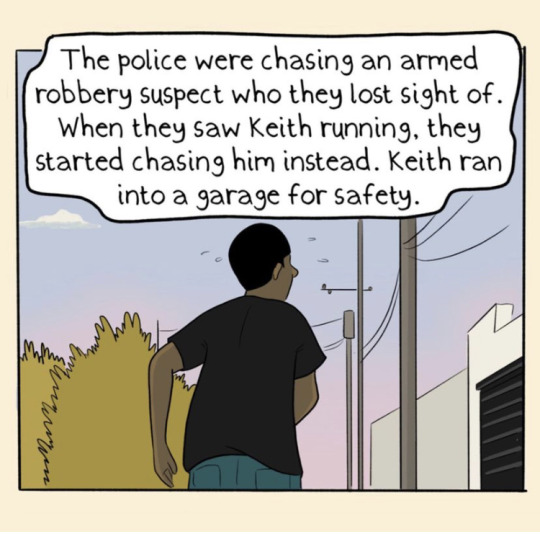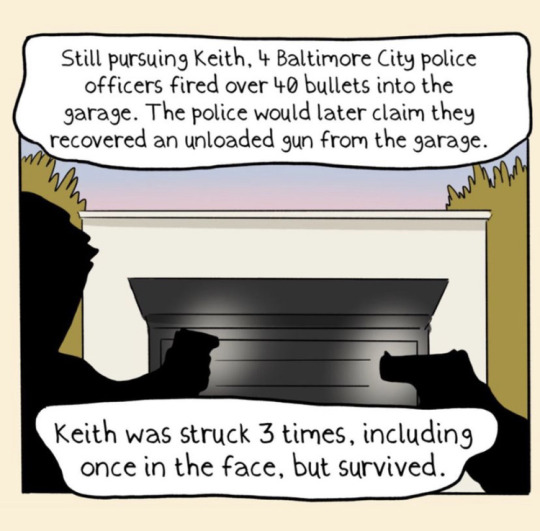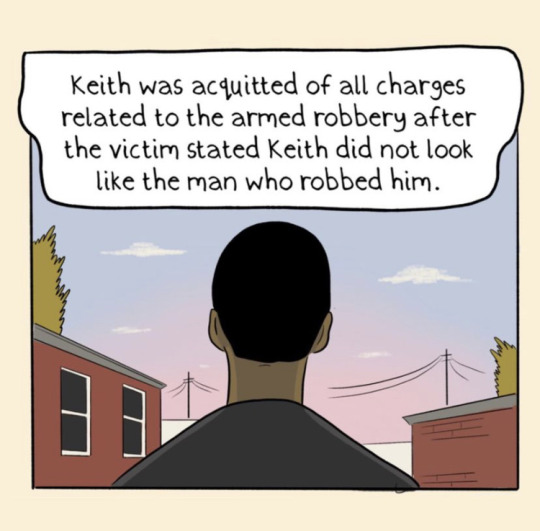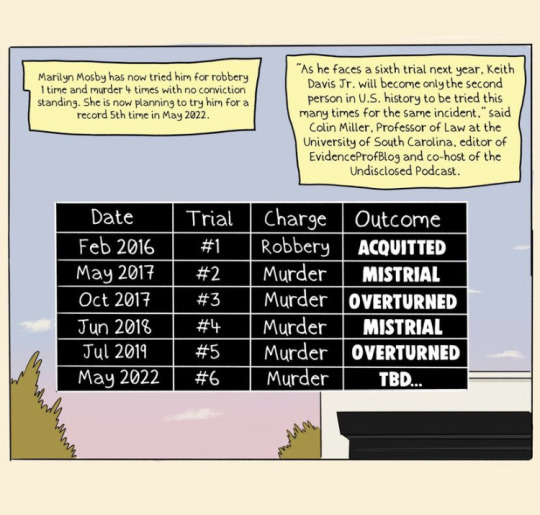#reprosecuting
Explore tagged Tumblr posts
Text
American "criminal justice" in action:
https://www.seattletimes.com/seattle-news/law-justice/why-prosecutors-in-wa-are-recharging-a-man-police-nearly-beat-to-death/
"Moses Lake police nearly beat Joseph Zamora to death. Then he was charged with and convicted of assaulting an officer. He served a full prison term. Then Grant County prosecutors asked for the case to be dismissed. Then the state Supreme Court threw out Zamora’s convictions, because the prosecutor used racial bias during the trial.
It’s been more than six years since the beating that left Zamora in a medically induced coma in the ICU for a month, but Grant County prosecutors are reprosecuting him for the same alleged crimes. Even though Zamora already served a full prison sentence. Even though the same prosecutors previously asked to have the case dismissed."
"Zamora’s confrontation with then-Moses Lake police Officer Kevin Hake happened in 2017. Hake stopped Zamora, who was walking to his niece’s home, after a neighbor called about a suspected car prowler. (It was later determined there was no car prowler.)
He tried to walk away, but Hake blocked him. A struggle ensued. Hake pulled his gun and placed it against Zamora’s ear and temple, and in his mouth.
Six officers eventually responded. Zamora was pepper-sprayed, tased, kicked, beaten and hog-tied. He had no pulse and was not breathing when paramedics arrived. A blood test later found amphetamine, methamphetamine and marijuana in his system.
In 2019, he was convicted of two counts of assaulting an officer."
And finally, a note on prosecutorial discretion:
"McCrae argued he’d done nothing wrong, that he was recharging Zamora because circumstances had changed and was acting within the powers granted to prosecutors to make charging decisions.
The Bar Association sided with him, dismissing the grievance."
And this is the person that is granted that discretion:
"The Supreme Court was wrong, McCrae wrote, when it said the neighbor’s report of a car prowler was mistaken. The Supreme Court “ignores the fact” that Zamora had a knife in his pocket and refused to remove his hand from his pocket. And it “ignores the fact that Hake had the ability to shoot Mr. Zamora and did not.”
...
“Ms. Trombley and the Supreme Court have managed, based on a poor decision by the prosecutor, to turn the case into an indictment of law enforcement, when the purpose of a criminal case is to hold an offender accountable,” McCrae wrote."
Because people should be grateful when the police only beat them into a coma, instead of shooting them, for attempting to walk away from an officer.
Because, as the prosecutor says, "the purpose of a criminal case is to hold an offender accountable."
Who is an offender?
Someone who the police don't like the look off. Someone who dares to be high (or mentally ill, or disabled, or black, or queer, or just poor) in public. Someone who doesn't sufficiently "comply" with law enforcement. Someone whose head injures an officer's hand, when the officer punches it multiple times.
(Also. A jury found him guilty. A jury of his peers agreed. Remember, should you every be called for jury duty. Remember your duty to your fellow citizens. Each member of that jury is responsible for this injustice as well.)
41 notes
·
View notes
Text
i couldnt make sense of the info in this post so i did a bit of googling and apparently this 5th murder trial was requested by davis' public defender:
The attorney, Deborah Katz Levi, director of special litigation for the public defender’s office, said it’s finally time for Baltimore State’s Attorney Marilyn Mosby to give up. “It is clear that another trial would not serve the interest of justice,” she wrote in an email. “The State’s Attorney now has the opportunity to see the error of her ways and decline to reprosecute Mr. Davis. After six years and five trials, her office has been unable to obtain a conviction, and Mr. Davis, who is innocent, deserves to go home, be with his wife, Kelly, and raise their children.”
but then he's also being prosecuted for attempted murder??
Please spread the word.









#this is unbelievable#two hung juries#and two overturned convictions#but they just cant give up bc that would mean having to admit that the police shot at an innocent man#what a mess
56K notes
·
View notes
Text
The original charges against Mr. Esformes were extensive and accused him of $1.3 billion in health care fraud involving money laundering, bribery and kickbacks.
0 notes
Text
Double Jeopardy Bars Retrial Where Prosecutor Caused Mistrial
The Nevada Supreme Court has held that double jeopardy bars retrial of a former health care executive where the prosecutor's misconduct led the defense to request a mistrial
In 2008, the State of Nevada filed an indictment against Lacy L. Thomas, the former chief executive officer of University Medical Center (UMC), charging five counts of theft and five counts of official misconduct. The charges related to contracts entered into between Thomas and five separate entities, which the State asserts were controlled by friends or associates of Thomas. The State contended that the terms of the five contracts were so grossly unfavorable to UMC that each contract represented an act of theft. One of these theft charges related to a contract negotiated by Thomas with Superior Consulting (ACS).
Thomas initially proceeded to trial in 2010. On approximately the fifth day of trial, an attorney for ACS, in a conversation with Thomas's attorneys outside of court, referred to a binder of documents that he believed to be exculpatory with respect to ACS. ACS's attorney indicated he had previously provided these documents to the police detectives investigating ACS and Thomas. These documents had never been provided to Thomas.
On the basis of this late disclosure, Thomas moved for a mistrial. The district court granted the motion on the tenth day of trial.
After a cursory review, the district court found that, at a minimum, the documents provided substantial material relevant to the cross examination of several key witnesses. Given that 13 witnesses had already testified over nine days of trial, the district court determined that a mistrial was necessary.
Conclusion
All evidence before the district court in this case suggests that the prosecutor intentionally and improperly withheld exculpatory documents. This conduct was egregious, and caused prejudice to Thomas which could not be cured by means short of a mistrial. Therefore, double jeopardy bars reprosecution of Thomas on all counts.
Accordingly, we grant Thomas's petition...
Justice Pickering dissented
The majority grants Thomas's petition for a writ prohibiting the district court from retrying him and directs dismissal of all charges against him. To reach this result, the majority overturns 35 years of settled law and embraces a state-constitution-based double-jeopardy test all federal and most state courts have rejected as unworkable and unsound. Questions of intent are quintessentially for the district judge, who sees firsthand what an appellate court only reads about. Despite this, and despite the district judge's familiarity with the facts, having presided over the aborted trial and the evidentiary hearing that followed, the majority deems "clearly erroneous" the district court's finding that the State did not intentionally suppress the compact disc or the documents it contained. The court then applies its new double-jeopardy test post hoc to an evidentiary hearing the district court and the parties conducted under prior law and, faulting the State for its lack of prescience, dismisses the case for a failure of essential proof under the court's new test.
...I do not condone the prosecution's failure to have turned over the ACS materials to the defense. But I do not believe the remedy for the discovery, or Brady, violation in this case is dismissal of all charges under Nevada's double jeopardy clause, as opposed to a new trial.
The Las Vegas Sun reported on the criminal case.
The case is Thomas v. Eighth Judicial District Court. (Mike Frisch)
http://ift.tt/2wvz9Qt
http://ift.tt/2wvz9Qt
0 notes
Text

DPIC made the decision at that time to maintain as comprehensive an innocence list as possible going forward. However, because of the inherent subjectivity of declaring a person innocent when some facts may remain in dispute, DPIC has adopted the objective criterion of “legal exoneration” for an individual to be included. What that means is that individuals who had been wrongfully convicted and sentenced to death were:
● Subsequently acquitted of all charges related to the crime that placed them on death row, either at retrial or by an appellate court determination that the evidence presented at trial was insufficient to convict;
● Had all charges related to the crime that placed them on death row dismissed by the prosecution or had reprosecution barred by the court in circumstances implicating the reliability of the evidence of guilt; or
● Been granted a complete pardon based on evidence of innocence.
This decision means that dozens of innocent individuals who had been coerced into entering pleas as a condition to obtaining their freedom after conviction for crimes they did not commit are not included in the list. It also means that individuals who are innocent of murder but still have a record of conviction for some offense related to the crime in which a person was killed are also not included on the list. As a result, the Innocence List is a conservative estimate that likely substantially understates the number of innocent people who have been wrongfully convicted and sentenced to death, and in some unknown and untrackable number of cases been wrongfully executed.
Since the House subcommittee’s release of DPIC’s initial Innocence List, the Death Penalty Information Center has been tracking new exonerations to add to the list and has occasionally removed cases from the list when new discoveries indicated that the individual had not been fully exonerated. During that time, the list has more than quadrupled from 43 to 174 death-row exonerations. However, DPIC had not had the opportunity to take a new look at old cases to see if there were exonerations we had not detected in our initial research.
In 2017, DPIC embarked on a multi-year project to ascertain the status of every death sentence imposed in the United States since the Furman decision. As part of this death-row census project, we have obtained and reviewed information from state departments of corrections, researchers, prosecuting and defense offices, court files and dockets, and news archives for more than 9,600 state, federal, and military death sentences imposed in the United States since July 1972. The project — the most ambitious to date in tracking modern U.S. death sentences — uncovered nearly two dozen older cases that at first glance appeared to qualify as death-row exonerations. Further research narrowed that number to the eleven cases we have now added to the Innocence List, expanding the list to 185 exonerations.
With these eleven prior exonerations added to the list, DPIC has undertaken an analysis of many of the geographic and demographic features of these cases and an examination of the factors contributing to wrongful capital convictions. The results are disturbing — not merely because of the frequency with which U.S. states wrongfully condemn the innocent to die but because of the reasons why.
It is widely acknowledged that any system that is run by human beings inevitably makes mistakes and that, despite our best efforts, innocent people will be sentenced to death. But our analysis of death-row exonerations shows that innocent people are sentenced to death in most states and in every region of the country that authorizes capital punishment. They can be sentenced to death anywhere, but are most often wrongfully condemned in states and counties with a history of aggressive pursuit of the death penalty or that authorize outlier practices that make it easier to impose capital sanctions.
Moreover, the data show that most wrongful capital convictions and death sentences are not merely accidental or the result of unintentional errors. Instead, they are overwhelmingly the product of police or prosecutorial misconduct or the presentation of knowingly false testimony. More likely than not, they involve a combination of the two.
The data show that for every 8.3 executions carried out in the United States, a wrongfully condemned death-row prisoner is exonerated. That is an appallingly and unacceptably high rate of error. And as the United States approaches the 50th anniversary of the Furman decision, it raises the fundamental question of whether we can trust our state and federal governments to fairly, honestly, and reliably carry out capital punishment.

2 notes
·
View notes
Text
[Eugene Volokh] The Double Jeopardy Clause, and Federal Prosecutions After State Prosecutions
The Double Jeopardy Clause generally bars the government from prosecuting a person twice for the same offense, regardless of whether the first prosecution led to an acquittal or a conviction. (If the first prosecution led to a hung jury, reprosecution is allowed.) But the Court has long held that this only bars reprosecution by the same sovereign: The federal government may reprosecute a person after a state prosecution (and vice versa, and in principle the same for multiple states, in the rare cases where multiple states both have jurisdiction over the crime).
In Commonwealth v. Sanchez (2016), Justices Ginsburg, joined by Justice Thomas, argued that this doctrine should be reexamined:
I write only to flag a larger question that bears fresh examination in an appropriate case. The double jeopardy proscription is intended to shield individuals from the harassment of multiple prosecutions for the same misconduct. Current "separate sovereigns" doctrine hardly serves that objective. States and Nation are "kindred systems," yet "parts of ONE WHOLE." The Federalist No. 82. Within that whole is it not "an affront to human dignity," Abbate v. United States (1959) (Black, J., dissenting), "inconsistent with the spirit of [our] Bill of Rights," to try or punish a person twice for the same offense? Several jurists and commentators have suggested that the question should be answered with a resounding yes: Ordinarily, a final judgment in a criminal case, just as a final judgment in a civil case, should preclude renewal of the fray anyplace in the Nation. The matter warrants attention in a future case in which a defendant faces successive prosecutions by parts of the whole USA.
Today, the Court agreed to consider the issue, in Gamble v. U.S. For an earlier petition that makes what strikes me as a powerful originalist argument against the "separate sovereigns" doctrine, see this 2013 certiorari petition written by my UCLA colleague (and legal historian) Stuart Banner.
0 notes